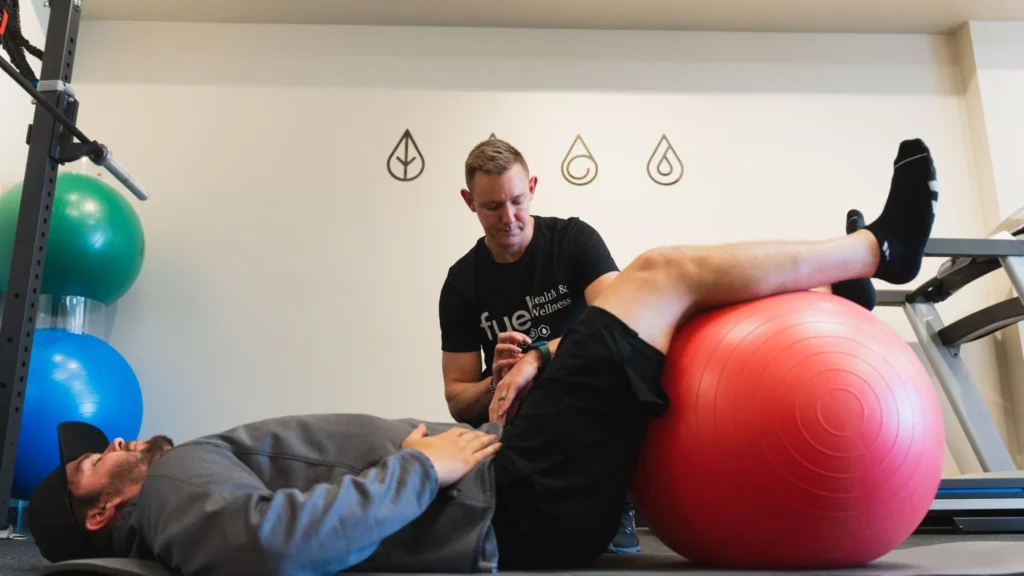Arthritis remains one of the most challenging chronic conditions affecting millions of people worldwide. Characterized by joint pain, stiffness, and reduced range of motion, arthritis not only affects physical mobility but also deeply influences overall quality of life. In the search for enduring solutions, physical therapy in Grand Rapids has emerged as a vital component of arthritis management and is often recommended by fuel health wellness professionals. Unlike a one-size-fits-all approach, physical therapy offers a personalized method to alleviate pain, restore function, and support long-term joint health.
By integrating various therapeutic techniques that target inflammation, muscle weakness, and joint instability, physical therapy can rejuvenate daily function while addressing the underlying issues that contribute to discomfort. Fuel Health & Wellness, a leader in health care services, demonstrates through its expert programs how a combination of manual therapy, exercise regimens, and modern modalities can be seamlessly integrated into arthritis treatment. Reviewed studies and clinical trials have shown that structured physical therapy not only relieves pain significantly but also improves flexibility and endurance, thereby reducing dependency on medications and expensive surgeries like knee or hip replacements.
With a focus on evidence-based practices, this article delves into the comprehensive aspects of how physical therapy transforms arthritis management. We will explore everything from the techniques used to the benefits seen in personalized treatment plans. The aim is to provide arthritis patients and healthcare professionals with a clear understanding of how physical therapy can be a game changer in overcoming the limitations imposed by arthritis. Prepare to discover detailed strategies that improve mobility, enhance pain management, and enable patients to regain independence in their everyday activities.
Key Takeaways
- Physical therapy is crucial in reducing arthritis pain, enhancing mobility, and supporting long-term joint health.
- Personalized treatment plans tailored to individual needs increase the effectiveness of therapy interventions.
- A broad range of modalities, including manual techniques and aquatic therapy, are used to address different aspects of arthritis.
- Overcoming access barriers with innovative options like telehealth ensures continued support for arthritis patients.
- Consistency in therapy combined with supportive lifestyle changes leads to improved quality of life and reduced arthritis symptoms.
Understanding the Importance of Physical Therapy for Arthritis

Physical therapy plays a pivotal role in managing arthritis by easing pain, restoring joint function, and enhancing overall mobility. In arthritis management, one of the first goals is to reduce pain and inflammation without solely relying on medications. Therapists use targeted exercises and manual therapy techniques to alleviate discomfort associated with inflamed joints, such as knees, hips, or hands. By working directly on the areas affected, physical therapy not only soothes pain but also promotes better circulation, which accelerates tissue healing and reduces stiffness.
Explore How Physical Therapy Alleviates Arthritis Pain
Physical therapy alleviates arthritis pain through a combination of manual therapies, therapeutic exercises, and modern modalities. Techniques such as joint mobilization and soft tissue manipulation help reduce pain by improving blood flow and releasing muscle tension. These interventions are designed to directly target the affected joints, thereby lessening the pressure on nerve endings and reducing the overall pain signal to the brain.
Clinical studies have found a reduction in reported pain levels by up to 30% after a few weeks of consistent therapy, offering a measurable benefit that can significantly enhance a patient’s daily comfort. Additionally, those experiencing ongoing discomfort may benefit from Ways to Manage Chronic Back Pain Through Therapy in Grand Rapids, which explores effective strategies for long-term relief.
Learn About the Benefits of Personalized Treatment Plans
Personalized treatment plans in physical therapy are tailored to an individual’s specific symptoms, physical condition, and lifestyle. Instead of adopting a generic approach, therapists conduct comprehensive assessments that include evaluating the range of motion, strength, and pain thresholds. Based on these evaluations, an individualized exercise regimen is formulated to target the weak muscles and bolster joint stability. This level of customization ensures that each patient receives care that addresses the unique challenges posed by their arthritis. For example, a patient suffering from severe stiffness might benefit from gentle stretching and aquatic therapy, while another with joint instability may require strength training combined with balance exercises.
Discover the Role of Physical Therapy in Improving Mobility
Improving mobility is a primary focus in physical therapy for arthritis. Joint stiffness can significantly impair a patient’s ability to perform even everyday tasks, such as walking or grasping items. Therapists design mobility-enhancing programs that include a blend of stretching exercises, aerobic activities, and targeted resistance training. By progressively increasing the intensity of these exercises, physical therapy helps restore the range of motion, enhances muscle coordination, and ultimately improves the quality of movements. Evidence shows that patients participating in structured physical therapy programs experience measurable gains in mobility—often reflected in improved gait analysis and balance tests.
Recognize How Therapy Supports Long-Term Joint Health
Long-term joint health is maintained through physical therapy by delaying degenerative changes and strengthening the muscles that support the joints. Regular exercise and therapy sessions can help reduce joint inflammation and wear by encouraging proper alignment and technique. The use of low-impact exercises is particularly effective in avoiding further stress on the joints while enhancing overall joint function. By consistently engaging in physical therapy, patients can significantly slow down the progression of arthritis, thereby reducing the likelihood of complications that could lead to joint replacement surgeries.
Identify the Best Therapy Techniques for Arthritis Relief
Various therapy techniques are employed in the management of arthritis, each targeting different aspects of the condition. Manual therapy, which includes mobilization and soft tissue massage, addresses muscle tension and joint restrictions. Meanwhile, exercise therapy focuses on improving strength and flexibility, utilizing resistance training, stretching, and low-impact aerobic exercises like cycling or swimming. In addition, modalities such as heat and cold therapy, ultrasound, and electrical stimulation are used to modulate pain and inflammation. Experts at Fuel Health & Wellness emphasize that a combination of these techniques, tailored to the patient’s needs, produces the best outcomes for arthritis relief.
Examine Patient Success Stories and Testimonials
Patient success stories serve as a powerful testament to the effectiveness of physical therapy. Many individuals with chronic arthritis have reported significant functional improvements after adhering to personalized therapy regimens. Testimonials often highlight experiences such as reduced dependency on pain medications, improved ability to perform daily tasks, and a renewed sense of independence. Detailed case studies reveal that patients regularly engaging in physical therapy have not only experienced pain relief but also enhanced emotional well-being. These testimonials underscore the transformative impact that a dedicated physical therapy program can have on individuals struggling with arthritis.
Common Physical Therapy Methods Used for Arthritis Relief

A multitude of physical therapy methods is available for arthritis relief, each addressing specific symptoms such as pain, stiffness, and muscle weakness. The diversity of these therapies ensures that treatment can be precisely matched to the patient’s condition and overall health goals. For arthritis sufferers, the aim is to reduce pain while improving functionality and preserving joint integrity. Different approaches ranging from manual techniques to innovative modalities ensure that therapy is both comprehensive and sustainable over the long term.
Investigate the Effectiveness of Manual Therapy Techniques
Manual therapy involves hands-on techniques that help relieve pain and improve joint mobility. Therapists use methods such as massage, joint mobilizations, and trigger point releases to break down soft tissue adhesions and decrease muscular tension. These techniques are particularly effective for patients experiencing localized pain and stiffness in affected joints. Research supports the use of manual therapy in reducing pain intensity, often offering immediate relief that can be felt within a few sessions. The personalized nature of these techniques also means that therapy can be adapted to the severity of arthritic symptoms, making them a cornerstone of physical therapy for arthritis.
Review Therapeutic Exercises for Arthritis Management
Therapeutic exercises are fundamental in managing arthritis, as they help in maintaining joint mobility and strengthening the muscles surrounding the joints. These exercises include stretching routines, balance activities, and resistance training, all of which are designed to improve overall joint function. Aerobic exercises, when performed correctly, enhance cardiovascular health while simultaneously reducing joint inflammation. For example, low-impact activities such as cycling or walking can stimulate joint lubrication and reduce pain. Moreover, therapy plans often integrate progressively challenging exercises to monitor improvements in strength and endurance, ensuring that patients remain engaged and see positive results over time.
Understand the Impact of Heat and Cold Therapy
Heat and cold therapies are simple yet effective methods frequently used in physical therapy to manage arthritis pain. Heat therapy, through methods such as hot water bottles or warm towels, helps relax and loosen tissues, increasing blood circulation to the affected area. This can be particularly beneficial before exercise sessions to prepare the joints for movement. Conversely, cold therapy is effective in reducing inflammation and numb sharp pain following physical activity or flare-ups. The alternating use of heat and cold can optimize therapy sessions by balancing the benefits of both approaches, providing sustained pain relief and improved joint function over time.
Learn About the Use of Assistive Devices in Therapy
Assistive devices such as braces, splints, and orthotics play an important role in supporting joints weakened by arthritis. These devices help stabilize joints during movement, reducing the strain placed on the muscles and soft tissues. In many cases, using an assistive device can prevent further joint damage and facilitate safer, more effective exercise routines. Studies have demonstrated that incorporating assistive devices into a comprehensive physical therapy program leads to improved functional outcomes. For example, knee braces can help correct alignment and reduce discomfort during walking or other weight-bearing activities, allowing patients to participate more confidently in their prescribed exercise routines.
Assess the Benefits of Aquatic Therapy for Joint Relief
Aquatic therapy is particularly beneficial for arthritis patients due to the buoyancy provided by water, which minimizes joint loading. Exercising in water can help improve strength, flexibility, and overall endurance without the risk of increased joint pain that may occur on land. The resistance provided by water also supports muscle strengthening while minimizing the risk of injury. Furthermore, aquatic therapy sessions often lead to significant improvements in mobility and balance, which are crucial for daily activities. Patients report feeling less pain and more energetic after regular sessions, making aquatic therapy a valuable component of a holistic arthritic treatment plan.
Compare Different Modalities to Find the Best Fit
Choosing the best physical therapy modality for arthritis involves comparing various techniques based on individual needs and preferences. Manual therapy, exercise regimens, aquatic therapy, and thermal interventions each offer unique advantages. For instance, while manual therapy can provide immediate pain relief, therapeutic exercises build long-term strength and stability. Similarly, aquatic therapy is ideal for patients with severe joint pain, and heat/cold application techniques offer practical, at-home relief options. By comparing these modalities, both patients and therapists can develop a layered approach that addresses multiple facets of arthritis, ensuring comprehensive care that adapts to evolving treatment needs.
The Role of a Physical Therapist in Arthritis Treatment Plans

The expertise of a physical therapist is critical in designing and implementing effective arthritis treatment plans. Physical therapists not only apply various therapeutic techniques but also serve as educators, guiding patients through safe exercise routines and lifestyle modifications. By thoroughly assessing the patient’s condition and considering their medical history, therapists develop customized programs that address both immediate pain relief and long-term joint health. Their role extends beyond mere symptom management; they empower patients to actively participate in their recovery process and make informed decisions about their health.
Discover How to Choose a Qualified Physical Therapist
Choosing a qualified physical therapist is a vital step for achieving optimal outcomes in arthritis treatment. Patients should look for therapists who possess relevant credentials, specialized training in musculoskeletal disorders, and substantial experience in treating arthritis. Recommendations from primary care providers or referrals from other patients can be invaluable. Moreover, it is important to select a therapist who listens carefully and tailors the treatment plan based on an individual’s specific symptoms and goals. Certifications from recognized bodies and a transparent treatment approach are key indicators of a therapist’s competence and commitment. By making an informed choice, patients can significantly increase their chances of achieving lasting improvements.
Understand the Assessment Process for Arthritis Patients
The assessment process performed by physical therapists is both comprehensive and methodical. It involves a detailed evaluation of joint mobility, muscle strength, range of motion, and pain levels. Additionally, therapists review the patient’s medical history, including any previous injuries or surgeries, to identify contributing factors to the current condition. Tools such as gait analysis and flexibility tests provide quantifiable data that influence the therapy plan. This thorough assessment helps in pinpointing the specific areas that require intervention and in establishing realistic, measurable goals. Such evaluations may also involve manual muscle testing and observational assessments during functional movements, ensuring that the treatment plan is closely aligned with the patient’s real-world challenges.
Learn How Therapists Tailor Individualized Programs
Individualized therapy programs are essential in managing arthritis effectively because each patient’s symptoms and challenges differ. Physical therapists work collaboratively with patients to design custom exercise regimens that address specific deficits—be it muscle weakness, joint instability, or limited range of motion. These programs often combine flexibility exercises, strength training, and balance improvement techniques. For instance, a patient with knee arthritis may focus on quadriceps strengthening and gentle stretching routines, while another with hand arthritis may require fine motor skills exercises alongside joint mobilization. This tailored approach not only maximizes the benefits of therapy but also enables patients to progress at a comfortable pace, ensuring the progressive enhancement of physical function without exacerbating pain.
Explore Communication Strategies With Your Therapist
Effective communication between the patient and the physical therapist is fundamental to the success of any therapy program. Open dialogue ensures that patients can express concerns about pain levels, exercise difficulty, and any changes in their symptoms. Therapists, in turn, provide clear instructions on proper form and necessary adjustments to the treatment plan. Regular check-ins, progress updates, and feedback sessions help to fine-tune the therapy regimen, ensuring that it remains aligned with the patient’s evolving needs. Many successful programs incorporate digital tools, such as patient portals or mobile apps, to facilitate ongoing communication and to track progress efficiently. This collaborative approach promotes trust and encourages patient engagement throughout their journey to recovery.
Discuss the Importance of Setting Achievable Goals
Setting achievable, realistic goals is critical in physical therapy as it helps maintain motivation and provides measurable outcomes. At the outset of treatment, therapists work with patients to establish short-term and long-term objectives—ranging from improving daily function to specific milestones like increasing walking distance without pain. These goals serve not only as benchmarks of progress but also as sources of encouragement when challenges arise. Regularly revisiting and adjusting goals based on progress ensures that the therapy plan remains dynamic and responsive. By celebrating small victories, patients are able to build confidence and view their recovery as a cumulative process, rather than a series of isolated exercises.
Evaluate Your Progress Through Consistent Follow-Ups
Frequent follow-up assessments are a vital component of physical therapy for arthritis. They allow the therapist to gauge the effectiveness of the treatment plan and make necessary modifications. Regular evaluations using standardized tests help track improvements in strength, range of motion, and pain reduction. This ongoing monitoring is key to ensuring that patients are on the right path toward recovery. Additionally, these evaluations provide an opportunity to address any concerns or setbacks, thereby optimizing the therapy process. Consistent follow-ups reinforce the commitment to treatment and encourage patients to remain engaged, leading to lasting improvements and a better quality of life.
Integrating Physical Therapy With Other Arthritis Treatments
Integrating physical therapy with other medical and self-management strategies is crucial for a holistic approach to arthritis care. While physical therapy focuses on improving joint function and alleviating pain through exercise and manual techniques, combining it with other treatments such as medication, nutritional changes, and alternative therapies can yield stronger outcomes. This multidisciplinary strategy addresses the complex, multifactorial nature of arthritis, ensuring that all contributing factors are managed concurrently. By developing a comprehensive treatment plan that spans physical therapy, pharmacologic interventions, and lifestyle modifications, patients are given the best opportunity to achieve sustained relief and improved quality of life.
Identify Complementary Therapies for Enhanced Results
Complementary therapies such as acupuncture, meditation, and guided imagery provide supportive benefits when integrated with physical therapy. These interventions help reduce stress, improve mental clarity, and promote relaxation, which can indirectly enhance the effectiveness of physical therapy. Acupuncture, for example, has been shown to reduce joint pain by modulating neural pathways and triggering the release of endorphins. Similarly, mindfulness practices and meditation can lower stress hormone levels, which in turn reduces inflammation. When used alongside targeted physical therapy programs, these complementary techniques create a synergistic effect that maximizes overall treatment outcomes by addressing both the physical and emotional aspects of arthritis.
Review the Benefits of Medication Alongside Therapy
Medications such as nonsteroidal anti-inflammatory drugs (NSAIDs), corticosteroids, and disease-modifying antirheumatic drugs (DMARDs) are often prescribed alongside physical therapy to manage arthritis. While these medications help control inflammation and reduce pain, they are most effective when used in conjunction with regular physical therapy. The combination addresses the symptoms as well as underlying muscular and joint weaknesses. Patients receiving a dual approach—pharmacological treatment to reduce acute inflammation and physical therapy to build strength and improve mobility—tend to experience faster and more sustained improvements. Regular monitoring ensures that medication dosages are adjusted as physical improvements occur, minimizing potential side effects and enhancing overall safety.
Explore Nutritional Considerations for Arthritis Sufferers
Nutritional strategies play an important role in complementing physical therapy for arthritis by addressing systemic inflammation and supporting joint health. A healthy diet rich in omega-3 fatty acids, antioxidants, and anti-inflammatory foods can help lower overall inflammation levels in the body, thereby enhancing the benefits of physical therapy. Foods such as fatty fish, green leafy vegetables, and nuts provide essential nutrients that support cartilage repair and improve joint lubrication. Moreover, nutritional adjustments, including weight management and balanced macronutrient intake, support the body’s healing process and can reduce mechanical stress on the joints. When combined with physical therapy, these dietary interventions contribute to a more integrated approach to managing arthritis.
Understand the Role of Lifestyle Changes in Treatment
Lifestyle modifications are integral to optimizing arthritis management, alongside physical therapy. Engaging in regular, low-impact exercise, ensuring adequate sleep, managing stress effectively, and maintaining a healthy body weight are all factors that contribute to improved joint function and reduced pain. Furthermore, simple changes—like incorporating ergonomic strategies at work and avoiding repetitive strain—can significantly reduce the burden on affected joints. A comprehensive treatment plan that merges physical therapy with practical lifestyle adjustments ensures that improvements are sustained over the long term. This integrated approach not only minimizes flare-ups but also supports overall physical and mental well-being.
Learn About Community Resources for Additional Support
Community resources, including support groups and local wellness programs, provide an additional layer of support for arthritis patients. Accessing community programs can help individuals share experiences, learn coping strategies, and stay motivated throughout their treatment journey. Local health clinics or Arthritis Foundations often offer workshops, exercise classes, and educational seminars tailored specifically for arthritis management. These resources complement physical therapy by providing a network of support that encourages adherence to the treatment plan, fosters social connections, and elevates overall well-being. Engaging with community services can empower patients to take charge of their health and drive better therapy outcomes.
Assess the Value of a Multidisciplinary Approach
A multidisciplinary approach that involves collaboration among physical therapists, physicians, nutritionists, and mental health professionals is essential for advanced arthritis treatment. This integrated method ensures that every aspect of a patient’s care—from pain management to emotional support—is addressed comprehensively. When each specialist contributes their expertise, treatment plans become more robust and personalized, yielding greater improvements in function and quality of life. Evidence suggests that patients who participate in multidisciplinary programs report higher satisfaction and better overall outcomes than those treated by a single provider. This approach underscores the importance of coordinated, patient-centered care in managing a complex condition like arthritis.
Overcoming Barriers to Accessing Physical Therapy

Despite the clear benefits of physical therapy in managing arthritis, patients often face several barriers that impede access to these essential services. Challenges such as high treatment costs, limited availability of specialized care, and geographical constraints can hinder individuals from receiving the required levels of support. In addition, factors like transportation difficulties, long waiting lists, and insurance limitations further complicate the ability to consistently engage in therapy. Addressing these barriers is crucial to ensure that all patients have equitable access to high-quality physical therapy services that can dramatically improve their arthritis outcomes.
Examine Common Challenges Faced by Arthritis Patients
Arthritis patients frequently encounter hurdles that make regular physical therapy sessions difficult to maintain. One of the primary obstacles is the financial burden associated with continuous therapy, as sessions can be costly when out-of-pocket expenses are involved. Additionally, patients living in rural or underserved urban areas may have limited access to specialized clinics or experienced therapists. Other challenges include scheduling conflicts, physical limitations that make travel difficult, and variability in the quality of care received. Understanding these common challenges is the first step in developing strategies to overcome them, ensuring that all individuals, regardless of their circumstances, receive the care they need.
Discuss Financial Options for Therapy Services
The cost of physical therapy can be a significant barrier for many arthritis patients, but various financial options may help alleviate this challenge. Many clinics offer sliding scale fees based on income, and some physical therapy services are covered under health insurance plans. Patients are encouraged to inquire about payment plans, community health programs, or government-funded rehabilitation services. Additionally, some organizations provide financial aid or grants specifically designed to support individuals with chronic arthritis. By exploring these financial avenues, patients can often reduce their out-of-pocket expenses and maintain regular access to quality physical therapy, ensuring that cost does not become a deterrent to long-term health improvement.
Understand the Importance of Health Insurance Coverage
Health insurance plays a critical role in determining access to physical therapy services. Comprehensive insurance plans often cover a significant portion of therapy costs, making it more affordable for patients to participate in regular sessions. However, the extent of coverage can vary widely based on the insurer and the specific plan details. It is important for patients to understand the benefits included in their health insurance policies and to work with their providers to maximize these resources. In many cases, documentation of arthritis severity and functional limitations can help secure additional coverage for necessary physical therapy services. Ensuring that patients are well-informed about their insurance options is a key component in overcoming treatment barriers.
Learn About Telehealth Options for Remote Therapy
Telehealth has emerged as a convenient alternative to traditional in-person physical therapy sessions, particularly for those facing geographic or mobility challenges. Virtual therapy sessions allow patients to consult with their physical therapists via video conferencing, ensuring that necessary guidance and support are available regardless of location. Telehealth also enables continuous monitoring and adjustment of therapy programs, making it easier to maintain progress without the need for frequent travel. This emerging option has proven especially valuable during periods when in-person appointments are not feasible, offering flexibility while maintaining the quality of care. As telehealth technology advances, it is set to become an integral component of the multidisciplinary approach to arthritis management.
Explore Local Resources for Support and Navigation
Local resources, such as community health centers and arthritis support groups, play an essential role in bridging the gap between patients and quality physical therapy services. These centers can offer solutions such as transportation services, group exercise classes, and patient education seminars. Local non-profits may also provide assistance in navigating financial aid programs and insurance paperwork. By leveraging community resources, patients are empowered with the knowledge and support necessary to overcome logistical and financial limitations. Engaging with local support networks not only enhances access to care but also fosters a sense of community and mutual encouragement among individuals facing similar challenges.
Identify Strategies for Maintaining Motivation
Maintaining motivation in the face of chronic arthritis can be challenging, but it is essential for effective physical therapy. Setting measurable, achievable short-term goals is one proven strategy to sustain progress. Additionally, regularly scheduled follow-up appointments and support groups can provide accountability and encouragement. Many patients find that tracking progress through journals or digital apps helps them remain focused and committed to their therapy programs. Celebrating small victories—such as increased range of motion or reduced pain levels—reinforces positive behavior and boosts morale. Strategies like these ensure that even when barriers arise, patients have a roadmap for success and the support needed to overcome obstacles.
Staying Consistent With Physical Therapy for Optimal Benefits
Consistency is the foundation of success in any physical therapy program for arthritis. Regular engagement in prescribed exercises and therapy sessions not only ensures continuous progress but also builds endurance and fosters long-term joint health. For patients dealing with the unpredictable nature of arthritis flare-ups, establishing a sustainable routine can be challenging. However, a structured schedule that integrates therapy into daily life is key to achieving lasting mobility and pain relief outcomes. Over time, consistent physical therapy not only alleviates current symptoms but also reduces the risk of future joint deterioration, supporting a better quality of life.
Create a Sustainable Therapy Schedule That Fits Your Life
Developing a sustainable therapy schedule involves working closely with a physical therapist to create a regimen that is both effective and manageable within daily routines. Patients are encouraged to identify specific times during the day when they can perform exercises consistently, whether it is early in the morning, during a lunch break, or in the evening. By fitting these sessions into a regular schedule, therapy becomes a habit rather than an occasional activity. Moreover, a structured schedule helps patients monitor their progress and adjust routines based on how their joints respond over time. This proactive approach leads to better outcomes and empowers patients to incorporate therapy seamlessly into their lifestyle.
Learn Ways to Stay Motivated During Treatment
Staying motivated throughout an ongoing treatment plan is essential for long-term success in managing arthritis. Patients may benefit from setting personal goals that are tracked over time, whether it’s being able to walk without pain for a certain distance or achieving a specific range of motion in a joint. Motivational tools such as progress journals, patient forums, and regular feedback from therapists can provide the encouragement needed to persevere. Additionally, switching up routines by incorporating various forms of exercise—like aquatic therapy, yoga, or tai chi—keeps the regimen interesting and ensures that multiple aspects of joint health are addressed. Consistent motivation is reinforced when patients see tangible improvements in their function and overall quality of life.
Discover Activities to Complement Therapy at Home
Complementary activities that can be performed at home often enhance the benefits of formal physical therapy. These activities include simple stretching routines, balance exercises, and low-impact aerobic workouts that help maintain joint flexibility and overall strength. Many patients also find that engaging in mindfulness practices or gentle yoga sessions provides additional relief from arthritis pain by reducing stress and promoting relaxation. By incorporating these supplementary exercises into their daily routine, patients can ensure that their joints remain active even on days when formal therapy sessions are not possible. This holistic approach not only reinforces the therapy provided in clinical settings but also contributes to a seamless integration of healthful practices into everyday life.
Understand the Importance of Regular Progress Tracking
Regular progress tracking is an important tool for ensuring the effectiveness of a physical therapy program for arthritis. This typically involves periodic assessments where therapists evaluate improvements in mobility, strength, and pain levels. Using standardized tools such as flexion measurements and gait analysis, therapists can obtain quantitative data that guides further adjustments to the therapy regimen. Patients who track their progress also gain a better understanding of their own bodies, which can be both motivating and informative when setting future goals. Digital apps and clinical records facilitate this ongoing evaluation, confirming that consistency in therapy is directly correlated with significant improvements over time.
Explore Community Programs for Accountability
Taking part in community programs, such as group exercise classes or arthritis support groups, can be instrumental in maintaining consistency with physical therapy. These programs not only offer additional guidance from professionals but also create a sense of camaraderie among participants who share similar experiences. Being part of a community that values health and wellness provides accountability—members often share progress updates, celebrate successes, and offer encouragement during setbacks. The social support derived from these programs fosters a positive treatment atmosphere, ensuring that patients remain engaged and committed to their therapy routines even when challenges occur.
Share Your Journey and Inspire Others With Arthritis
Sharing personal experiences can have a profound impact on both the patient and the wider arthritis community. When patients document and share their therapy journey—whether through blog posts, support groups, or social media—they not only reinforce their own commitment to the regimen but also inspire others facing similar challenges. Testimonials, progress photos, and shared milestones create a network of support that promotes consistency and mutual accountability. This culture of shared experience can transform individual therapy from an isolated endeavor into a collective journey toward enhanced mobility and a better quality of life. By engaging with others, patients contribute to a broader narrative of hope and resilience in the face of arthritis.
Final Thoughts
Physical therapy is a cornerstone of effective arthritis management, offering both immediate relief and long-term improvements in joint health. Through personalized, targeted interventions, patients experience reduced pain, enhanced mobility, and a renewed quality of life. Integrating physical therapy with complementary treatments and overcoming access barriers further amplifies its benefits. With consistent commitment and support from healthcare professionals, physical therapy provides arthritis sufferers with the tools to reclaim independence and maintain long-term wellness. For more information and personalized guidance, please contact us.
Frequently Asked Questions
How does physical therapy alleviate arthritis pain?
Physical therapy reduces arthritis pain through targeted manual techniques, therapeutic exercises, and modalities such as heat and cold interventions. These methods enhance blood circulation, relax tense muscles, and reduce inflammation, leading to significant pain relief.
Can physical therapy improve long-term joint health in arthritis patients?
Yes, by strengthening surrounding muscles and improving joint stability, physical therapy not only alleviates pain but also supports long-term joint health. Consistent sessions help delay degenerative changes and can reduce the need for invasive surgeries.
How do personalized treatment plans benefit arthritis patients?
Personalized treatment plans are tailored to an individual’s specific symptoms, lifestyle, and medical history. This comprehensive approach addresses the unique challenges each patient faces, leading to more effective relief and functional improvements over time.
What role does telehealth play in arthritis physical therapy?
Telehealth offers remote access to expert guidance, allowing patients to continue their therapy sessions despite geographic or mobility challenges. Virtual consultations ensure continuous progress monitoring and timely adjustments to the therapy program.
How can patients maintain motivation throughout their physical therapy treatment for arthritis?
Patients can stay motivated by establishing a sustainable schedule, setting achievable goals, tracking progress regularly, and engaging in community support groups. Sharing success stories and receiving continuous feedback from therapists also helps reinforce commitment and boost morale.


